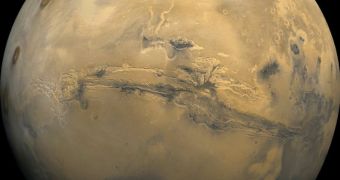Investigators were recently able to determine an interesting fact about the Red Planet, when they learned that an area of land near the volcano Olympus Mons shows signs of having been modeled by tectonic activities in recent geological times.
The finding is very important because experts believe our neighboring planet has been inactive in this way for millions of years. Discovering signs that this is not the case could produce a reshaping of our understanding of Mars' interior.
The region that researchers analyzed as part of the study effort features a wide variety of indicators that tectonic processes were at work there, including a large number of ridges and scarps. Experts believe these may be signs of thrusting from the ground below.
What's even more interesting is the fact that fact that the activity may have taken place withing the last 250,000 years or so, which is extremely recent in geological timescales. If this is confirmed, then science will have to change its vision on Mars' recent past.
At this point, conventional wisdom has it that tectonic processes most likely did not play a very important role in the reshaping of Mars' surface in the past few million years.
If the discover next to Olympus Mons is validated, then the theory would be infirmed. “People don't want there to be plate tectonics on Mars,” study author An Yin explains.
The researcher, who is based at the University of California in Los Angeles (UCLA), presented the group's discovery at the 2010 annual fall meeting of the American Geophysical Union (AGU), in San Francisco.
“But I think there's good evidence for it,” the expert says. There are several issues with this however, mostly because Mars is a lot smaller as a plant than Earth is.
The Red Planet is half as wide as Earth, and has only some 11 percent of its weight. The leading theory is that these dimensions made the celestial body cool faster in the earliest days of the solar system.
As a direct result, the thinking goes, plate tectonics would have stopped, given that all the heat driving it was lost. If the new finding is confirmed, then this line of thought will be proven false.
“People inside the Mars community are pretty resistant. But a lot of other people are very excited about these findings,” Yin explains, quoted by Space.
Although the researcher's idea are fairly radical and out there, Yin is not alone in supporting the new ideas. Other experts have been proposing the existence of plate tectonics on Mars for a long time.

 14 DAY TRIAL //
14 DAY TRIAL //